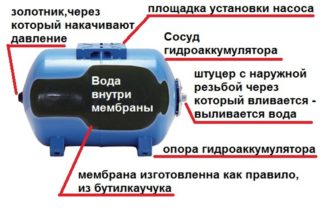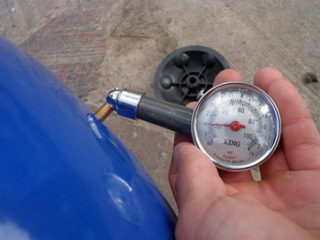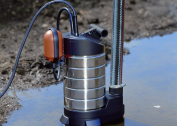The accumulator plays an important role in the water supply system. It serves to maintain a constant pressure, allows you to automate the water supply process, protects the motor from premature wear and breakage, protects pipelines from water hammer.
One of the most important characteristics of this device is the pressure in the receiver, which is the air cavity of the storage water tank, which is separated from the water by a sealed rubber membrane. With incorrect settings, the pressure in the pipes starts to “jump” when water is supplied, undesirable frequent trips of the water pump relay occur. As a result, the impossibility of normal operation of the water supply system and the premature failure of the electric hydraulic pump.
 The material of the elastic membrane deforms over time, and the pressure in the storage tank may decrease.
The material of the elastic membrane deforms over time, and the pressure in the storage tank may decrease.
To ensure the normal operation of the water supply system, the optimal pressure value in the accumulator is calculated, it is correctly set up and subsequent monitoring is carried out with a frequency of 1 to 2 times a year.
All this can be done independently, without having at hand any special tools and special skills. About this - below.
When carrying out maintenance work, do not forget to check the system for leaks. In the presence of undetected leaks, efforts to configure the equipment can simply be nullified!
Why do I need to create pressure in the accumulator
Lowering the pressure below normal will cause the pump station to turn on too often. With a significant decrease in pressure, the pump starts almost immediately after opening the water tap. Accordingly, when closing the tap, the hydraulic pump switches off almost instantly. In addition, frequent cycles of the relay lead to the failure of the electric pump.
Optimal parameters
 The main factors that affect the operation of the water supply network and the life of the hydraulic equipment are as follows:
The main factors that affect the operation of the water supply network and the life of the hydraulic equipment are as follows:
- Proper calculation of the maximum and minimum pressure values at which the pump must be turned on (off).
- Correct pressure adjustment in the receiver.
The pressure of the preliminary air injection is 1.5 - 2 bar (depending on the volume of the tank). The determination of the air pressure for operation in tandem with a specific pump station is based on the factory parameters of the pressure switch. The average pressure at which the pump is turned on is between 1.4 and 1.8 bar. The cut-off threshold is usually in the range of 2.5 - 3 bar. The optimal value of air pressure should be 10-12% less than the pressure on the pump.
Calculation example. The pressure switch is configured to start the pump at a pressure of 2 bar. The air pressure in the receiver is 2-0.2 = 1.8 atm.
If these requirements are met, after turning off the hydraulic pump, a certain amount of water is stored in the storage tank, which is sufficient to create a stable pressure until the next pump start.
How to check the pressure in the accumulator
 During measurements, the tank must be empty. To do this, turn off the pumping station, open the water tap and wait for the moment when the water supply stops.
During measurements, the tank must be empty. To do this, turn off the pumping station, open the water tap and wait for the moment when the water supply stops.
To measure pressure, you must:
- unscrew the cap that closes the fitting with the spool located on the tank body;
- connect the manometer to the spool (you can use an electronic or automobile manometer), take a reading and compare with the calculated value;
- if the pressure level decreases, pump up the compressor to the optimum value;
- release air to reduce pressure.
If the adjustment is carried out before the hydraulic tank is included in the system, it must be left for a day. After this time, after the control measurement, the device is installed.
How to adjust the pressure
The proper operation of the pumping station is determined by three main parameters:
- Start pressure;
- Shutdown pressure;
- Air pressure in the hydraulic tank.
The first two parameters determine the operation mode of the pressure switch. Adjustment is carried out empirically, while in order to improve the accuracy of measurement, verification can be performed several times.
As part of an electric relay: two vertically arranged springs. They are located on the axles and are tightened with nuts. One of the springs (larger diameter) is used to adjust the value of the switching pressure, the spring of a smaller diameter is used to regulate the required difference between the values of the starting pressure and the pump shut-off pressure. The springs abut against the membrane, which closes and opens the contacts of the control circuit.
 The start threshold is set by turning the adjusting nut. When turned clockwise, the pump start pressure increases. Rotating counterclockwise reduces the switching pressure.
The start threshold is set by turning the adjusting nut. When turned clockwise, the pump start pressure increases. Rotating counterclockwise reduces the switching pressure.
The adjustment process is carried out in the following sequence:
- Measurement of air pressure in the receiver using an external pressure gauge (for example, automobile), if necessary - pumping with a hand pump or compressor to a calculated value. It is carried out with the pump turned off after a complete pressure relief.
- Measurement of pump start pressure. With the pump turned on, but not working, open the valve to relieve pressure and take the pressure gauge from the system when the relay was triggered (when the pump station starts).
- Trigger pressure adjustment. If the obtained pressure does not coincide with the required nut of the large spring, turn it up or down. At the end of the control measurement, if necessary, repeat the operation (possibly several times).
- Pump shutdown pressure measurement. Close all drain valves and wait for the pump to shut off.
- Adjustment of the difference in pressure levels for starting and stopping the pump. If the calculated value of the shutdown threshold of the pumping station does not match, turn the spring nut of a smaller diameter in the corresponding direction. The spring is very sensitive: turn to carry out a maximum of 1/4 - 1/2 turn. After making a control measurement, repeat the steps if necessary.
- Repeating the cycle described in paragraphs 1 - 5. If necessary, repeat the procedure several times until the desired parameters are achieved.
The required start and shutdown parameters are indicated in the relay passport. Operating pressure air in the receiver indicated in the battery certificate. It should be 10-12% less than the start pressure.
Depending on the number of storeys of the building and the number of water consumers, it becomes necessary to change the factory parameters when adjusting the relay. After that, be sure to check the air pressure and adjust it in accordance with the new settings.
It is worth noting that the described technology for monitoring and tuning battery parameters is the same for all types of this product, regardless of configuration (vertical or horizontal design), volume and design features. The same is true for heating and hot water systems.
It is not necessary to be a specialist in order to carry out simple operations to check and adjust the pressure in the accumulator, having a minimum of simple tools.Simple actions that do not require any skills will take a minimum of time, while paying off with reliable uninterrupted operation of the water supply system for a long time.


